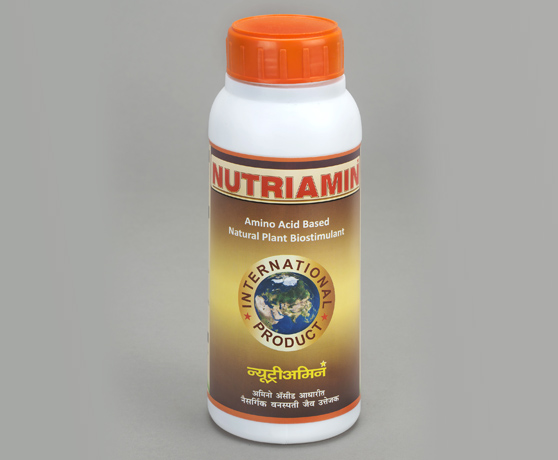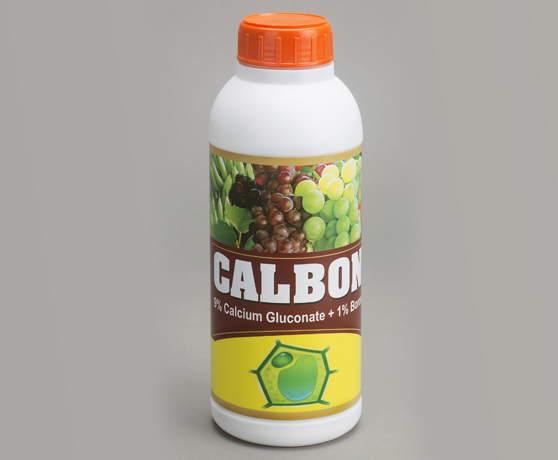


INTRODUCTION
- Nutriamin is derived from animal origin proteins.
- Nutriamin is composed of Free Amino acids, Peptides and medium chain Polypeptides
- Nutriamin is able to penetrate both through Stomata of leaves and through epidermis.
- Molecular Weight
- Protein is the most complex unbroken structure. It can reach a molecular weight of millions of Daltons.
- Following them in Complexity are Peptones that are long chain amino acids chains with an approximate weight of 100,000 Daltons.
- Polypeptides are medium chains with molecular weight of 10,000 to 20,000 Daltons.
- Peptides are Amino acids with molecular weight of 1000 to 2000 Daltons.
- Free amino acids having molecular weight of 200 to 500 Daltons are the smallest.
- Free Amino acids provoke quick reaction in crops, whereas Peptides and Polypeptides take longer to assimilate within the plant.
MORE DETAILS
| Total Nitrogen(N) | 8.80% | Free Amino Acids | 11.70% |
| Ammonia Nitrogen | 0.60% | Total Organic Matter | 57.00% |
| Organic Nitrogen | 8.20% | Organic Carbon | 18.00% |
- Colour-Brown; pH.-6.5; Density – 1.25
- Nutriamin Aminogramme:- amino acids in w/w
| Amino acid | W/W | Amino acid | W/W |
|---|---|---|---|
| FREE AMINO ACIDS% | 11.70 | ASPARTIC ACID % | 0.40 |
| ISOLUCINE % | 2.30 | ARGININE % | 0.40 |
| HYDROXIPROLINE% | 2.30 | TYROSINE% | 0.30 |
| GLICINE % | 0.20 | PHYNYLALANINE% | 0.30 |
| ALANINE % | 1.20 | LEUCINE % | 0.30 |
| PROLINE% | 1.20 | HISTIDINE % | 0.10 |
| SERINE% | 0.70 | THERONINE % | 0.10 |
| VALINE % | 0.70 | METHONINE% | 0.10 |
| GLUTAMINIC ACID% | 0.60 |
Amino acids are the building blocks of all proteins. Proteins are formed by sequence of Amino Acids. Amino acids have two isomers which are dextrorotatory (D) and laevorotatory (L). D-Amino Acids are not recognized by the enzymatic locus and therefore cannot participate in protein synthesis in plants. L-amino acids should be in the form of Free Amino Acids or in the form of small peptides for them to be absorbed by plants. Large molecules with a high molecular weight cannot be absorbed and further used by plants. There are 20 protein amino acids.
Plants are able to synthesize all the amino acids. Amino acids are required by plants throughout all their growing stages.
Amino acids are important in the following functions.
Amino acids are important in the following functions.
- The starting points for the synthesis of cellular molecules including vitamins, nucleotides, chlorophyll, enzymes, proteins, etc.
- They have an important nutritional function during germination, during the synthesis of proteins (enzymes and structural proteins, etc); in the formation of phytohormones such as auxins, ethylene, polyamines, porfirines etc.
- Regulation of the water balance especially when plants are under stressful conditions.
- Amino acids also act as chelating molecules of essential nutrients for normal development of the plant.
Under optimum growing conditions, plants synthesize their own L-amino acids through thousands of chemical reactions and by a significant use of energy. However, when growing under stressful conditions, plants decrease or stop the synthesis of carbohydrates and consequently the production of L-amino acids. Instead plants have to hydrolyze or break down structural proteins to obtain the required L-amino acids. These activities require an extraordinary use of energy by plants and contribute to the reduction of root mass and the quality of plants.
The synthesis of amino acids is costly for plants in relation to the energy requirement. This energy expense is especially important in the moments when the plant physiology is not optimum. Studies have proved that Amino Acids can directly or indirectly influence the physiological activities of the plant.
The synthesis of amino acids is costly for plants in relation to the energy requirement. This energy expense is especially important in the moments when the plant physiology is not optimum. Studies have proved that Amino Acids can directly or indirectly influence the physiological activities of the plant.
Stress Resistance – High temperature, low humidity, frost, pest attacks, hailstrom and floods have negative effects on metabolism with corresponding reduction in crop quality and quantity. The applications of amino acids before, during and after the stress conditions supply plants with amino acids which are directly related to stress physiology and thus have preventing and recovering effects.
Effect Of Photosynthesis– Plants synthesize carbohydrates by photosynthesis, and chlorophyll is responsible for the absorption of light energy. A low photosynthesis rate implies a slow growth leading to death of plants. Glycine and Glutamic acid are fundamental metabolites in the process of formation of vegetable tissue and chlorophyll synthesis. These amino acids help to increase chlorophyll concentration in plant leading to higher degree of photosynthesis. This makes crop lush green.
Amino Acids and Phytoharmones – Amino Acids are precursors or activators of phytoharmones and Growth substances. L-Methionine is precursor of ethylene and growth factor such as Spermine and Spermidine, which are synthesized from 5- Adenosylemethionine. L-Tryptophan is precursor for auxin synthesis. L-Argimine induces synthesis of flower and fruit related hormones.
Pollination and Fruit Formation – L-Lysine, L-Methionine, and L-Glutamic Acid are essential amino acids for pollination. These amino acids increase the pollen germination and are responsible for the length of pollen tube.
Equilibrium of Soil Flora – The equilibrium of microbial flora of the agriculture soil is a basic question for good mineralization of the organic matter and also for a good soil structure and fertility around the roots. L-Methionine is precursor of growth factors that stabilize the cell walls of the microbial flora. Amino Acids supplied to plant by incorporating them into the soil helps in improving the microflora of the soil thereby facilitating the assimilation of nutrients.
Effect Of Photosynthesis– Plants synthesize carbohydrates by photosynthesis, and chlorophyll is responsible for the absorption of light energy. A low photosynthesis rate implies a slow growth leading to death of plants. Glycine and Glutamic acid are fundamental metabolites in the process of formation of vegetable tissue and chlorophyll synthesis. These amino acids help to increase chlorophyll concentration in plant leading to higher degree of photosynthesis. This makes crop lush green.
Amino Acids and Phytoharmones – Amino Acids are precursors or activators of phytoharmones and Growth substances. L-Methionine is precursor of ethylene and growth factor such as Spermine and Spermidine, which are synthesized from 5- Adenosylemethionine. L-Tryptophan is precursor for auxin synthesis. L-Argimine induces synthesis of flower and fruit related hormones.
Pollination and Fruit Formation – L-Lysine, L-Methionine, and L-Glutamic Acid are essential amino acids for pollination. These amino acids increase the pollen germination and are responsible for the length of pollen tube.
Equilibrium of Soil Flora – The equilibrium of microbial flora of the agriculture soil is a basic question for good mineralization of the organic matter and also for a good soil structure and fertility around the roots. L-Methionine is precursor of growth factors that stabilize the cell walls of the microbial flora. Amino Acids supplied to plant by incorporating them into the soil helps in improving the microflora of the soil thereby facilitating the assimilation of nutrients.
- L-Proline and Hydroxyl – Proline acts mainly on the hydro balance of plant, strengthening the cellular walls in such a way that they increase resistance to unfavorable climatic conditions.
- L-Alanine, L-Valnine and L-Leucine improve quality of fruits.
- L-Histidine helps in proper ripening of fruits
Nutriamin can be used in every type of crop except plum tree. Amino acid is a stimulant and it is best to apply it when crop is in a stress phase:
- After a dry/cold spell or excessive water logging
- Stress caused by a plant protection treatment.
- A delayed crop and so on.
- It helps to the young plants to grow up fast.
- For Foliar Application.1.5-2 ml/ lit
- For Soil Application: 1-1.5 lit / acre by fertigation
- Don't apply on Plum Tree.
- Do not mix with Sulphur, Oils or very alkaline products.
- Don' t use at high application rate mixed with copper products In general,
- Nutriamin can be mixed with water soluble fertilizer , chelated / inorganic micronutrients and pesticides,
Keep out of the reach of children, In case of contact with eyes, wash immediately with plenty of water.


